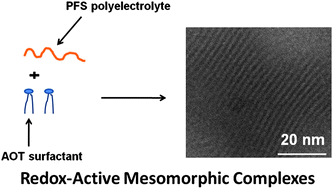Redox-active mesomorphic complexes from the ionic self-assembly of cationic polyferrocenylsilane polyelectrolytes and anionic surfactants
Abstract
The concept of ionic

* Corresponding authors
a
School of Chemistry, University of Bristol, Bristol, UK
E-mail:
ian.manners@bristol.ac.uk, charl.faul@bristol.ac.uk
Fax: +44 (0)117 929 0509
Tel: +44 (0)117 925 1295
b Nara National College of Technology, 22 Yatacho, Yamato-Koriyama, Nara, Japan
c Department of Applied Physics, Aalto University School of Science and Technology, P.O.Box 15100, Aalto, Finland
The concept of ionic

 Please wait while we load your content...
Something went wrong. Try again?
Please wait while we load your content...
Something went wrong. Try again?
R. Ahmed, M. Hsiao, Y. Matsuura, N. Houbenov, C. F. J. Faul and I. Manners, Soft Matter, 2011, 7, 10462 DOI: 10.1039/C1SM06374J
To request permission to reproduce material from this article, please go to the Copyright Clearance Center request page.
If you are an author contributing to an RSC publication, you do not need to request permission provided correct acknowledgement is given.
If you are the author of this article, you do not need to request permission to reproduce figures and diagrams provided correct acknowledgement is given. If you want to reproduce the whole article in a third-party publication (excluding your thesis/dissertation for which permission is not required) please go to the Copyright Clearance Center request page.
Read more about how to correctly acknowledge RSC content.
 Fetching data from CrossRef.
Fetching data from CrossRef.
This may take some time to load.
Loading related content
